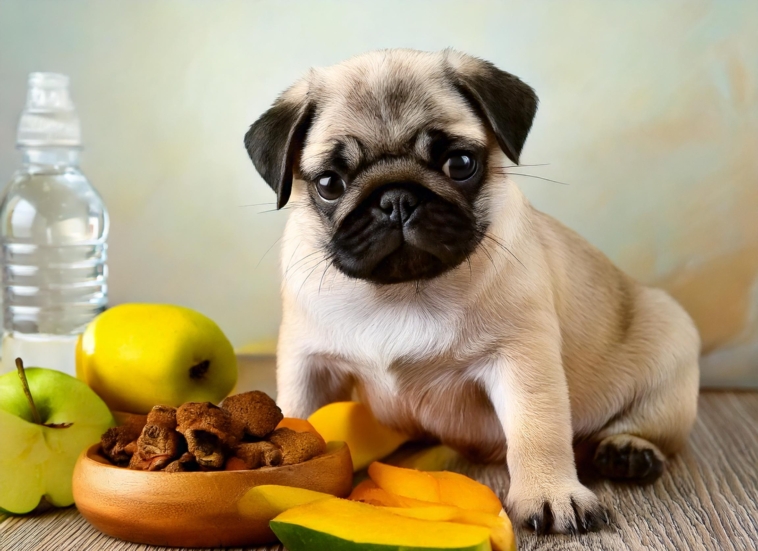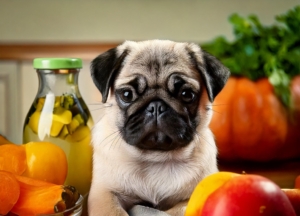Feeding a Pug Puppy: A Guide to Raising a Snorty Little Gourmet
Feeding a pug puppy isn’t just about filling a bowl—it’s about nourishing a tiny, judgmental roommate who thinks every snack is owed to them. So, let’s dive into the art of keeping your wrinkled sidekick healthy, happy, and only mildly offended that you’re not constantly offering treats.
Start With the Basics: What Goes in the Bowl
A balanced meal means a healthy, snorting, zoomie-filled pug. Here’s what you need to know:
- Good Stuff Only: If “corn” or “soy” is taking center stage in the ingredient list, dump it like it’s hot. Check for whole meat, actual veggies, and grains you’re familiar with.
- Right Amount of Fuel: Pug pups require just enough power, not all-you-can-eat-power. Opt for 22% protein and 8% fat.
- Staple Vitamins & Minerals: Consider DHA, calcium, and phosphorus the brain- and bone-fortifying dream team.
- Portion Control: Your puppy doesn’t have a sense of “full.” Utilize those feeding recommendations on the package and don’t give in to puppy dog eyes.
And yes—call your vet if you’re not sure. They speak both dog and human panic.
Homemade Food vs. Commercial Food: The Showdown
Homemade Food: Because You’re Basically a Dog Chef Now
Pros:
- You’re the master of the ingredients. No surprise preservatives.
- You can customize it for allergies, medical requirements, or finicky royal palates.
- You’ll be able to tell exactly what’s in the bowl—no mystery meat.
Cons:
- Time-consuming. Like, “You now cook two dinners a day” level.
- It takes actual smarts to get a canine diet balanced.
- Your vet may be seeing you more often than your family.
Commercial Food: Fast, Convenient, and Slightly Magical
Pros:
- Pour and go. Boom—meal served.
- Gourmet-balanced nutrients, no equations needed.
- Shaped, colored, and flavored to taste more upscale than your own dinner.
Cons:
- Quality of ingredients can be hit or miss. Some bags are gourmet; some are… filler.
- Preservatives and additives may creep in.
- Higher-end brands can cost more than your coffee addiction.
What’s on the Menu? A Nutrient Breakdown
Your pug puppy isn’t merely in search of taste—has to have nutrients that power zoomies and nap time.
- Protein: Forms muscles and enables tail-wagging. Find chicken, fish, turkey—no mystery meats.
- Fat: Maintains that coat shiny and energy level boosted. Fish oil or flaxseed are the top options.
- Carbs: Believe it or not, even pugs enjoy carbs. Opt for sweet potatoes or brown rice—they’re delicious and easy to digest.
- Vitamins: A through K. Pug puppies are essentially multivitamin sponges.
- Minerals: Calcium and phosphorus = healthy bones and more bouncy zoomies.
- Water: The actual MVP. Pugs don’t need much–just perpetual hydration.
Feeding Times: Because Structure Prevents Chaos
Your pug puppy’s routine is pretty much: eat, play, poop, nap, repeat. Help make the chaos adorable.
Feeding Quantities:
- Weigh your pup frequently.
- Look at the packaging of their food for serving sizes. Yes, read the fine print.
- Trim portions if your pug is suddenly getting fatter or speedier.
Feeding Routine:
- 3 to 4 meals a day when they’re babies.
- Scale back to 2 meals a day as they mature.
- Make meal times regular—pugs are theatrical about surprises.
Pug-Specific Diet Drama: The Usual Suspects
Pugs are sensitive hearts (and bellies). Keep an eye out for:
- Obesity: Pugs are expert beggars. Don’t indulge. Small body = increased risk.
- Allergies: Usual suspects: soy, grains, certain proteins. Look for itchy coat, sneezing, or drama.
- Irritable Bowel: Delicate tummies require plain, good food. Think “spa menu,” not “gas station spread.”
- Gas: If your pug is making whoopee cushion sounds, check the fiber and carbs.
- Gingivitis: Dry kibble to scrub out those little teeth and keep dragon breath away.
Healthy Treats: Bribes That Won’t Backfire
Yes, treats are life. But not all treats are equal.
- Veggies: Carrot sticks, green beans, sweet potatoes—crunchy, healthy, low-calorie.
- Fruits: Apples (no seeds!), blueberries, banana bits—sweet without the sugar crash.
- Lean Meats: A few bites of cooked chicken or turkey = instant loyalty.
- Dental Chews: Delicious and secretly good for oral health.
- Commercial Treats: Go grain-free, additive-free, drama-free.
Water: The Unsung Hero of Puppy Wellness
Hydration is not a choice. It’s life.
Water assists with:
- Digestion and nutrient uptake
- Preventing your pug from overheating during zoomies
- Smooth joint mobility (particularly for those adorable little legs)
- Flushing out the “bad stuff”
Signs your pug is running low on water:
- Tired or sluggish (well, more than the norm)
- Dry gums
- Skin takes a very long time to snap back after a pinch
Fresh, clean water needs to be kept available at all times. Pug equivalent to room service.
Switching Diets Without a Stomach Rebellion
Pugs don’t take well to sudden change—especially in their food bowl.
How to switch diets without causing a full-blown gastrointestinal protest:
- Day 1–2: Combination of 25% new food and 75% old food.
- Day 3–5: Half and half.
- Day 6–7: 75% new, 25% old.
- Day 8+: Full new diet. No drama.
If your pug becomes a soap opera star—vomiting, diarrhea, sulking—slow down or consult the vet.
Supplements: Necessary or Just Extra?
You don’t need to feed your pug puppy supplements—unless:
- The food isn’t completely balanced (oh no).
- The vet instructs you to.
- You’re addressing a particular thing, such as joint problems or dry skin.
If you’re going shopping for supplements, avoid shady brands. Premium only, please, or don’t bother. And always, always get the thumbs up from your vet first.
Spotting Food Sensitivities: CSI: Pug Edition
Sometimes your pug puppy just doesn’t approve of what’s on the menu. Keep an eye out for:
- Itchy skin or redness: May be an allergy.
- Upset tummy: Vomiting or loose poop = red flag.
- Wheezing or sneezing: Some foods just don’t get along with them.
- Ear infections: Yessiree, these can be food-induced.
- Changes in behavior: From zoomies to Zzz’s—or the reverse.
Call the vet. They may recommend an elimination diet (which sounds scary but is a huge help).
Move It to Lose It: Exercise Meets Nutrition
Even the best diet won’t help if your pug’s idea of cardio is rolling over in their sleep.
Benefits of regular activity:
- Keeps the pounds off (pugs = walking meatballs if you’re not careful)
- Protects those stubby joints
- Keeps their brain sharp and tantrum-free
Start slow: short walks, fetch in the hallway, or a zoomie-friendly backyard romp. Watch for heavy breathing these snort machines need rest too.
Growth Checks: Because Your Vet Isn’t Just for Emergencies
Regular check-ups keep your pug puppy on track (and off the donut-shaped weight gain treadmill).
Monitor:
- Behavior or appetite changes
- Monthly weigh-ins
- Current vaccinations
- Red flags such as fatigue, limping, or sneaky poops
- Teeth, ears, and eyes—because yucky things come on fast
Pug Puppy Diet FAQ: Rapid-Fire Answers to Common Questions
Q: How often should I feed my pug puppy?
A: 3–4 times a day when they’re little. Down to 2 meals as they grow. No buffet tables.
Q: What food is best?
A: Premium puppy food, fresh veggies and fruits in moderation, and lean meats. Hold the fries.
Q: What foods are banned?
A: Chocolate, grapes, raisins, onions, garlic, and anything that looks like Halloween candy.
Q: How much food should they eat?
A: Check the back of the food bag. Then weigh your pug, and check again. Adjust as needed.
Final Woof of Wisdom:
Feeding your pug puppy is half science, half art, and all love. Use high-quality food, treat with affection (and carrots), and when in doubt—let your vet guide the way. A healthy pug is a happy pug, and a happy pug is… well, still pretty judgy, but cute anyway.





